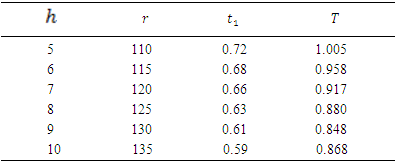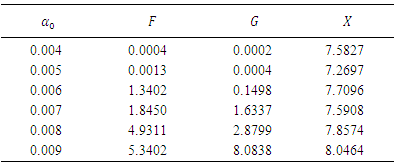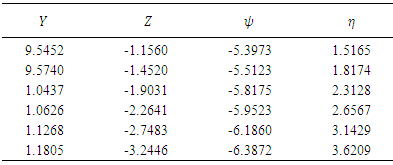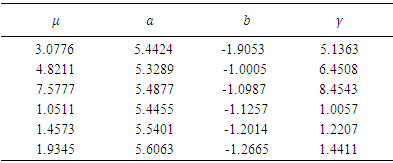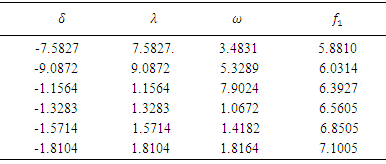| [1] | Abbasbandy. S. and Ghanbari. R. Nuraeiandm (2013): Revision of sign distance method for ranking of fuzzy numbers, Iranian Journal of Fuzzy Systems vol. 10, no. 4, (2013) pp. 101-117 101. |
| [2] | Ackoff R L and Sasieni M W (1993): Fundamentals of Operations Research, Wiley Eastern Ltd. |
| [3] | Dinagar, D.S. and Kannan, J.R. (2015): On fuzzy inventory model with allowable shortage, International journal of pure and applied mathematics, 99, 1, pp. 65-76. |
| [4] | Dutta D. and Kumar P. (2012): Fuzzy inventory model without shortage using trapezoidal fuzzy number with sensitivity analysis, IOSR-Journal of Mathematics, vol. 4(3), pp.32-37. |
| [5] | Dutta D. and Kumar P. (2013): Fuzzy inventory model for deteriorating items with shortage under the fully backlogged condition, IJSCE, 3(2), pp.393-398. |
| [6] | Dutta D. and Kumar P. (2013a): Optimal policy for an inventory model without shortages considering fuzziness in demand, holding cost and ordering cost, International Journal of Advanced Innovation and Research, vol. 2(3), pp.320-325. |
| [7] | Dubois D. and Prade H. (1978): Operations on fuzzy numbers, International Journal of Systems Science, vol. 9(6), pp.613-626. |
| [8] | De P. K. and Rawat A. (2011): A fuzzy inventory model without shortages using triangular fuzzy number, Fuzzy Information & Engineering, vol. 1, pp.59-68. |
| [9] | Harris F. (1915): Operations and cost, AW Shaw Co. Chicago. |
| [10] | Hsieh C. H. (2002): Optimization of fuzzy production inventory models, Information Sciences, vol. 146(1-4), pp.29-40. |
| [11] | Jeffery J. Leader (2004): Numerical Analysis and Scientific Computation, Pearson Addition Wesley, Boston, San Francisco, New York. |
| [12] | Jain R. (1976): Decision making in the presence of fuzzy variables, IIIE Transactions on systems, Man and Cybernetics, vol. 17, pp.698-703. |
| [13] | Jaggi C. K., Pareek S., Sharma A. and Nidhi (2012): Fuzzy inventory model for deteriorating items with time-varying demand and shortages, American Journal of Operational Research, vol. 2(6), pp.81-92. |
| [14] | Kacpryzk J. and Staniewski P. (1982): Long-term inventory policy-making through fuzzy-decision making models, Fuzzy Sets and Systems, vol. 8, pp.117-132. |
| [15] | Kao C. K. and Hsu W. K. (2002): A single-period inventory model with fuzzy demand, Computers and Mathematics with Applications, vol. 43, pp.841-848. |
| [16] | Kumar S. D., Kundu P. K. and Goswami A. (2003): An economic production quantity inventory model involving fuzzy demand rate and fuzzy deterioration rate. Journal of Applied Mathematics and Computing, vol. 12(1-2), pp.251-260. |
| [17] | Kumar, S. and Rajput, U.S. (2015): Fuzzy inventory model for deteriorating items with time dependent demand and partial backlogging, American journal of operations research, 6, 3, pp.496-509. |
| [18] | Lengari John Yen Reza (2005): Fuzzy Logic Intelligence, Control an Information Pearson Prentice Hall, Pearson education, Inc. |
| [19] | Mishra S. S., Pandey H. and Singh R.S. (2004): A fuzzified deteriorating inventory model with breakdown of machine and shortage cost, International Journal of Mathematical Science 3, 241-255. |
| [20] | Mishra S. S. and Mishra P. P. (2011): A (Q, R) model for fuzzified deterioration under cobweb phenomenon and permissible delay in payment, Computers and Mathematics with Applications, Vol. 61, No. 4, pp. 921-932. |
| [21] | Mishra S. S., Yadav S. K. and Rawat S. (2015): Inventory flow in supply chain with deteriorating items for customers in queue: computation of profit optimization in fuzzy environment, American Journal of Operations Research, Scientific and Academic Publishing,p-ISSN:2324-6537e-ISSN:2324-6545,5(1): 1-8,doi:10.5923/j.ajor.ajor201501. |
| [22] | Mahata G.C. and Goswami A. (2007): An EOQ model for deteriorating items under trade credit financing in the fuzzy sense, production planning and control 18, 681-692. |
| [23] | Mishra (2014): Developing intelligent index for fuzzified inventory of supply chain by using neural computing, International Journal of Operations Research, Inderscience, accepted. |
| [24] | Mishra S. S. and Mishra P.P. (2012), Phase Wise Supply Chain Model of EOQ with Normal Life Time for Queued Customers: A Computational Approach, American Journal of Operations Research,2, 296-307,doi:10.4236/ajor.2012.23036. |
| [25] | Park K. S. (1987): Fuzzy set theoretical interpretation of economic order quantity, IEEE Trans. Systems Man. Cybernet SMC, vol. 17, pp.1082-1084. |
| [26] | Pathak S. and Sarkar (Mondol) S. (2012): A fuzzy EOQ inventory model for random Weibull deterioration with Ramp-Type demand, partial backlogging and inflation under trade credit financing, Int. J. Res. Commer. IT Manag. 2(2), 8-18. With ISSN 2231-5756. |
| [27] | Prasath G. M. Arun and Seshaiah C. V. (2013): A fuzzy production-distribution inventory model with shortage, International Journal of Innovation and Applied Studies, vol. 2, pp. 131-137. |
| [28] | Pathak S., Kar S. Sarkar (Mondal) S. (2013): Fuzzy production inventory model for deteriorating items with shortage under the effect of the time dependent learning and forgetting: a possibility/necessity approach, OPSEARCH (Apr-Jun 2013) 50(2): 149-181. |
| [29] | Roy A. and Maiti M. (2009): An inventory model for deteriorating item with displayed stock dependent demand under fuzzy inflation and time discounting over a random planning horizon, Appl. Math. Model 33(2), 744-759. |
| [30] | Roy A., Maity K., Kar, S. and Maity M. (2008): A production inventory model with remanufacturing for defective and usable items in fuzzy environment, Comput. Ind. Eng. 56, 87-97. |
| [31] | Syed J. K. and Aziz L. A. (2007): Fuzzy inventory model without shortages using signed distance method, Applied Mathematics & Information Sciences, vol. 1(2), pp.203-209. |
| [32] | Saha S. and Chakrabarti T. (2012): Fuzzy EOQ model for time dependent deteriorating items and time dependent demand with shortages, IOSR-Journal of Mathematics, vol. 2(4), pp.46-54. |
| [33] | Saneifard Rahim and Saneifard Rasoul (2011): A method for defuzzification based on centroid point, TJFS: Turkish Journal of Fuzzy Systems (eISSN: 1309–1190) An Official Journal of Turkish Fuzzy Systems Association Vol.2, No.1, pp. 36-44. |
| [34] | Sen, N. and Malakar, S. (2015): A fuzzy inventory model with shortages using different fuzzy numbers, American journal of mathematics and statistics, 5, 5, pp. 238-248. |
| [35] | Van Leekwijck W. and Kerre E. E. (1999): Defuzzification: criteria and classification, Fuzzy Sets and Systems 108 (2): 159–178. doi:10.1016/S0165-0114(97)00337-0. |
| [36] | Vujosevic M., Petrovic D. and Petrovic R. (1996): EOQ formula when inventory cost is fuzzy”, International Journal of Production Economics, vol. 45, pp.499-504. |
| [37] | Yao J. S. and Lee H. M. (1999): Fuzzy inventory with or without backorder for fuzzy order quantity with trapezoidal fuzzy number, Fuzzy sets and systems, vol. 105, pp.311-337. |
| [38] | Yao J. S. and Lee H. M. (1999a): Economic order quantity in fuzzy sense for inventory without backorder model, Fuzzy Sets and Systems, vol. 105, pp.13-31. |
| [39] | Yao J. S. and Chiang J. (2003): Inventory without back order with fuzzy total cost and fuzzy storing cost defuzzified by centroid and signed distance, European Journal of Operational Research, vol. 148, pp.401-409. |
| [40] | Zadeh L.A. (1965a): Fuzzy sets and system, In: Fox J, Editor. System Theory, Brooklyn NY: Polytechnic Press, pp.29–39. |
| [41] | Zadeh (1965): Fuzzy sets, Information Control, vol. 8, pp.338-353. |
| [42] | Zadeh L.A. and Bellman R.E. (1970): Decision making in a fuzzy environment, Management Science, vol. 17, pp.140-164. |
| [43] | Zadeh L.A. (1978): Fuzzy Set as a basis for a theory of possibility, Fuzzy Set Syst.1,3-28. |
| [44] | Zimmerman H. J. (1983): Using fuzzy sets in operational research, European Journal of Operational Research, vol. 13, pp.201-206. |
| [45] | Zimmermann H. J. (2001): Fuzzy Set Theory and its Applications, Springer. |



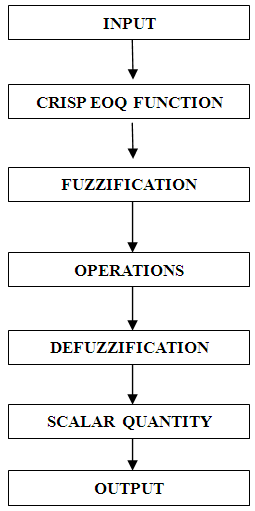
 : Ordering cost per order.ii.
: Ordering cost per order.ii.  : Holding cost per unit per unit time.iii.
: Holding cost per unit per unit time.iii.  : Shortage cost per unit time.iv.
: Shortage cost per unit time.iv.  : Purchasing cost per unit per unit time.v.
: Purchasing cost per unit per unit time.v.  : Demand rate at any time t per unit time.vi.
: Demand rate at any time t per unit time.vi.  : Deterioration rate function, where
: Deterioration rate function, where  .vii.
.vii.  : Length of each ordering cycle.viii.
: Length of each ordering cycle.viii.  : Order quantity per unit.ix.
: Order quantity per unit.ix.  : Total shortage cost per unit time.x.
: Total shortage cost per unit time.x.  : Total cost per unit time.xi.
: Total cost per unit time.xi.  : Total cost per unit time in fuzzy environment.xii.
: Total cost per unit time in fuzzy environment.xii.  : The inventory level at any instant of time t,
: The inventory level at any instant of time t, 

 at time t, which is the rate of change of inventory and is governed by the following differential equation:
at time t, which is the rate of change of inventory and is governed by the following differential equation: 

 and the boundary condition
and the boundary condition


 , we ignore higher power of term of
, we ignore higher power of term of  , and get
, and get
 in (3.6), we get
in (3.6), we get








 is rate of deteriorating during production
is rate of deteriorating during production changes into fuzzified deterioration rate
changes into fuzzified deterioration rate  , and equation (3.14) becomes
, and equation (3.14) becomes
 and let traingular membership function of fuzzified dereriotion rate
and let traingular membership function of fuzzified dereriotion rate  be given as
be given as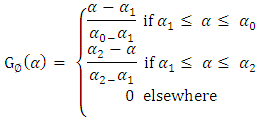 where
where  are the positive variables and
are the positive variables and  and the centroid of
and the centroid of  is given as
is given as We further observe that
We further observe that  This shows that
This shows that  , where
, where  are lower, middle and upper cost at time t from above equation and we can express membership function for cost at time t
are lower, middle and upper cost at time t from above equation and we can express membership function for cost at time t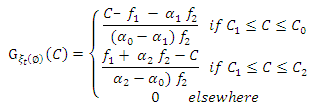 As we know the extension principle of Zadeh is a very important tool in the fuzzy set theory for providing procedure to fuzzify a crisp function which is given below. Let f:
As we know the extension principle of Zadeh is a very important tool in the fuzzy set theory for providing procedure to fuzzify a crisp function which is given below. Let f:  be a crisp function and F(m) (respectively F(n)) be the set of all fuzzy sets ( called fuzzy power set ) of M (respectively n ). The function f:
be a crisp function and F(m) (respectively F(n)) be the set of all fuzzy sets ( called fuzzy power set ) of M (respectively n ). The function f:  induces two functions f:
induces two functions f:  and f-1:
and f-1:  and the extension principal of Zadeh gives formulas to compute the membership function of fuzzy sets f (A ) in N ( respectively f-1 ( B ) in M ) in terms of membership function of fuzzy set A in M ( respectively B in N ).Definition 4.1 (Zadeh’s Extension Principle): In terms of the notations introduced above, extension principle of Zadeh states that
and the extension principal of Zadeh gives formulas to compute the membership function of fuzzy sets f (A ) in N ( respectively f-1 ( B ) in M ) in terms of membership function of fuzzy set A in M ( respectively B in N ).Definition 4.1 (Zadeh’s Extension Principle): In terms of the notations introduced above, extension principle of Zadeh states that
 Hence, from the above theorem, we get the following equation as
Hence, from the above theorem, we get the following equation as Now, we find the quantities
Now, we find the quantities  and
and  so that we can find centroid for defuzzification as
so that we can find centroid for defuzzification as
 The centroid to
The centroid to  is given by
is given by  which gives the total cost in fuzzified environment. We have
which gives the total cost in fuzzified environment. We have  and
and  as
as After evaluating integrals of
After evaluating integrals of  and
and  from the above equations, we get the centroid of
from the above equations, we get the centroid of  as
as  , which finally turns out to be
, which finally turns out to be For obtaining optimal solution of
For obtaining optimal solution of  , i,e for total cost of the model, we take first order partial derivatives w. r. t.
, i,e for total cost of the model, we take first order partial derivatives w. r. t.  and equating them to zero with the condition of
and equating them to zero with the condition of  . Note that
. Note that  is given by as
is given by as  Similarly, we can differentiate w. r. t.
Similarly, we can differentiate w. r. t.  , and get
, and get 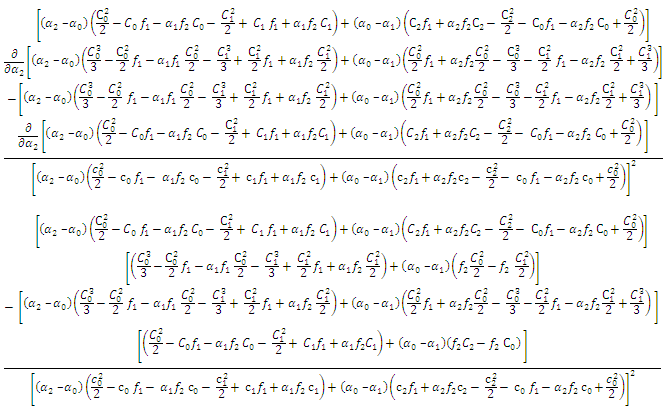 After solving both partial derivatives with respect to
After solving both partial derivatives with respect to  for fixed values of
for fixed values of  and t, we get a system of non-linear equations for
and t, we get a system of non-linear equations for  respectively as follows:
respectively as follows: 

 This system of non-linear equations in
This system of non-linear equations in  given by (4.2) and (4.3) is solved by using fast converging N-R method which is programmed in C++.
given by (4.2) and (4.3) is solved by using fast converging N-R method which is programmed in C++.  Step iv: Compute the lower cost.Step v: Compute the middle cost.Step vi: Compute the upper cost.Step vii: Compute the coefficient of first non-linear equation by Jacobi method.Step viii: Compute the coefficient of second non-linear equation by Jacobi method.Step ix: Compute optimal value of alpha one.Step x: Compute optimal value of alpha two.Step xi: Compute optimal value of cost in fuzzy case.Step xii: End.
Step iv: Compute the lower cost.Step v: Compute the middle cost.Step vi: Compute the upper cost.Step vii: Compute the coefficient of first non-linear equation by Jacobi method.Step viii: Compute the coefficient of second non-linear equation by Jacobi method.Step ix: Compute optimal value of alpha one.Step x: Compute optimal value of alpha two.Step xi: Compute optimal value of cost in fuzzy case.Step xii: End. Abstract
Abstract Reference
Reference Full-Text PDF
Full-Text PDF Full-text HTML
Full-text HTML
